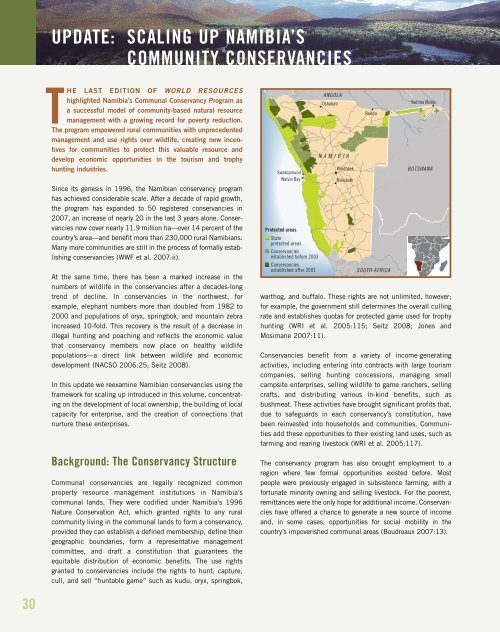Growing the Wealth of the Poor - World Resources Institute
Growing the Wealth of the Poor - World Resources Institute
Growing the Wealth of the Poor - World Resources Institute
Create successful ePaper yourself
Turn your PDF publications into a flip-book with our unique Google optimized e-Paper software.
UPDATE: SCALING UP NAMIBIA’SCOMMUNITY CONSERVANCIESTHE LAST EDITION OF WORLD RESOURCEShighlighted Namibia’s Communal Conservancy Program asa successful model <strong>of</strong> community-based natural resourcemanagement with a growing record for poverty reduction.The program empowered rural communities with unprecedentedmanagement and use rights over wildlife, creating new incentivesfor communities to protect this valuable resource anddevelop economic opportunities in <strong>the</strong> tourism and trophyhunting industries.Since its genesis in 1996, <strong>the</strong> Namibian conservancy programhas achieved considerable scale. After a decade <strong>of</strong> rapid growth,<strong>the</strong> program has expanded to 50 registered conservancies in2007, an increase <strong>of</strong> nearly 20 in <strong>the</strong> last 3 years alone. Conservanciesnow cover nearly 11.9 million ha—over 14 percent <strong>of</strong> <strong>the</strong>country’s area—and benefit more than 230,000 rural Namibians.Many more communities are still in <strong>the</strong> process <strong>of</strong> formally establishingconservancies (WWF et al. 2007:ii).At <strong>the</strong> same time, <strong>the</strong>re has been a marked increase in <strong>the</strong>numbers <strong>of</strong> wildlife in <strong>the</strong> conservancies after a decades-longtrend <strong>of</strong> decline. In conservancies in <strong>the</strong> northwest, forexample, elephant numbers more than doubled from 1982 to2000 and populations <strong>of</strong> oryx, springbok, and mountain zebraincreased 10-fold. This recovery is <strong>the</strong> result <strong>of</strong> a decrease inillegal hunting and poaching and reflects <strong>the</strong> economic valuethat conservancy members now place on healthy wildlifepopulations—a direct link between wildlife and economicdevelopment (NACSO 2006:25; Seitz 2008).In this update we reexamine Namibian conservancies using <strong>the</strong>framework for scaling up introduced in this volume, concentratingon <strong>the</strong> development <strong>of</strong> local ownership, <strong>the</strong> building <strong>of</strong> localcapacity for enterprise, and <strong>the</strong> creation <strong>of</strong> connections thatnurture <strong>the</strong>se enterprises.Background: The Conservancy StructureCommunal conservancies are legally recognized commonproperty resource management institutions in Namibia’scommunal lands. They were codified under Namibia’s 1996Nature Conservation Act, which granted rights to any ruralcommunity living in <strong>the</strong> communal lands to form a conservancy,provided <strong>the</strong>y can establish a defined membership, define <strong>the</strong>irgeographic boundaries, form a representative managementcommittee, and draft a constitution that guarantees <strong>the</strong>equitable distribution <strong>of</strong> economic benefits. The use rightsgranted to conservancies include <strong>the</strong> rights to hunt, capture,cull, and sell “huntable game” such as kudu, oryx, springbok,SwakopmundWalvis BayProtected areasStateprotected areasConservanciesestablished before 2003Conservanciesestablished after 2003ANGOLAOshakatiN A M I B I AWindhoekRehobothRunduSOUTH AFRICAKatima MuliloBOTSWANAwarthog, and buffalo. These rights are not unlimited, however;for example, <strong>the</strong> government still determines <strong>the</strong> overall cullingrate and establishes quotas for protected game used for trophyhunting (WRI et al. 2005:115; Seitz 2008; Jones andMosimane 2007:11).Conservancies benefit from a variety <strong>of</strong> income-generatingactivities, including entering into contracts with large tourismcompanies, selling hunting concessions, managing smallcampsite enterprises, selling wildlife to game ranchers, sellingcrafts, and distributing various in-kind benefits, such asbushmeat. These activities have brought significant pr<strong>of</strong>its that,due to safeguards in each conservancy’s constitution, havebeen reinvested into households and communities. Communitiesadd <strong>the</strong>se opportunities to <strong>the</strong>ir existing land uses, such asfarming and rearing livestock (WRI et al. 2005:117).The conservancy program has also brought employment to aregion where few formal opportunities existed before. Mostpeople were previously engaged in subsistence farming, with afortunate minority owning and selling livestock. For <strong>the</strong> poorest,remittances were <strong>the</strong> only hope for additional income. Conservancieshave <strong>of</strong>fered a chance to generate a new source <strong>of</strong> incomeand, in some cases, opportunities for social mobility in <strong>the</strong>country’s impoverished communal areas (Boudreaux 2007:13).30
















